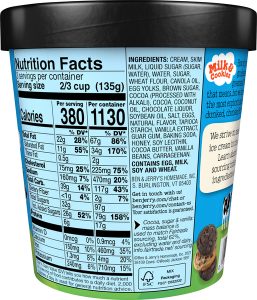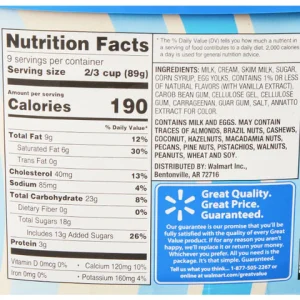4 Chapter 4: Understanding Calories, Food Labels, and Digestion
MyPlate Recommendations and Nutrient Intake Patterns
We learned in the last chapter that MyPlate provides general nutritional recommendations by showing the recommended amounts of fruits, vegetables, grains, proteins, and dairy in a balanced meal. The primary audience for this textbook will be college students around 20 years of age. The MyPlate model provides specific daily recommendations for a 20-year-old adult. Despite the helpful visual aid that is MyPlate, many 20-year-olds, and Americans overall, fail to meet the minimal suggested intake, especially when it comes to fruits and vegetables. National statistics show that the majority of people fall well short of meeting the USDA’s recommended daily intake. This is concerning because eating an adequate number of fruits and vegetables is strongly associated with a lower risk of all-cause mortality, cardiovascular disease, and type 2 diabetes.
Below are the daily guidelines from MyPlate for the average 20-year-old American adult:
| Daily Intake Categories | Women | Men |
| Calories | 1800–2400 | 2600–3200 |
| Fruit | 1.5–2 cups | 2–2.5 cups |
| Vegetables | 2.5–3 cups | 3.5–4.0 cups |
| Protein foods | 5.0–6.5 oz | 6.5–7 oz |
| Grains | 6–8 oz | 9–10 oz |
| Dairy | 3 cups | 3 cups |
On average, Americans consume only 1-2 servings of fruits and vegetables per day, and younger adults and teens consume even less (CITATION). Moreover, where you live matters. Americans living in the Southeast are far less likely to meet their recommended intake of fruits and vegetables.
Fruit and vegetable inadequacy is not the sole reason Americans have an unhealthy diet. The three largest culprits eaten in significant excess in the typical American diet are:
- Added sugars
- Unhealthy fats (especially saturated and trans fats)
- Sodium
Chronic conditions such as hypertension and heart disease are largely caused by these overconsumed nutrients, but added sugars and fats are most significantly associated with weight gain and obesity.
Food Labels and Calorie Awareness
Added sugar and fat are flavorful and can be low satiety, meaning it is easy to consume too much of them. Chronically overconsuming these nutrients can lead to weight gain because a person may quickly exceed their calorie intake without realizing it. MyPlate provides a useful summary of meal planning, but it doesn’t inform users about calorie and nutrient density. Americans must learn to read Nutrition Facts labels in order to completely comprehend what is in a particular meal. This is a lifelong skill that enables individuals to make more informed dietary decisions.
The U.S. FDA revised food labels in 2016 to increase readability, usability, and make key information more obvious to the American public glancing at a nutrition label.
The mandatory Nutrition Facts label changes in 2016 included:
- Significantly larger and bolder calorie numbers were added to aid customers in quickly determining a food item’s energy content.
- An “Added Sugars” category below “Total Sugars” to differentiate naturally occurring sugars (e.g., natural sugar in fruit) from those added during processing.
- Updated serving sizes with a slightly larger font for “Serving size” to more closely reflect what people typically eat, rather than idealized portion sizes.
- Updated Daily Values (DV%) for nutrients such as vitamin D, dietary fiber, and sodium that help consumers in determining if a food is high or low in a given nutrient.
- Elimination of “Calories from Fat” next to the calorie content to shift the focus toward fat quality (e.g., unsaturated vs. saturated), rather than fat quantity alone.
While MyPlate gives a helpful overview of how meals should be structured, it does not educate consumers on calorie content or nutrient density. To fully understand what’s in a given food, individuals must learn to read Nutrition Facts labels—a lifelong skill that empowers people to make more informed dietary choices.
Interpreting Food Labels: Real-World Practice
We can put this knowledge to use in a practical sense when examining food labels of calorie-dense snack items. For example, let’s analyze an ice cream container:
- Calories per serving: This indicates the amount of energy you get from each serving size.
- Serving size: The portion that is calculated to be consumed in a single sitting; it can often be deceptively small.
- Servings per container: Frequently more than one, indicating that the overall number of calories in the container is more than initially thought.


Look at the label on this ice cream container. Notice the calories per serving, the serving size, and the number of servings per container.
This exercise demonstrates the ease with which consumers can underestimate their consumption. Even though a “pint” of ice cream may have four servings, if someone eats the entire container, which is typical, they are consuming four times the listed amount of sugar, fat, and calories.
Examining more conventional foods like ramen or bagels also reveals typical pitfalls:
- Even if they don’t taste sweet, added sugars are present in many bagels and breads.
- Granola bars or snacks that are marketed as healthy often contain a high amount of added sugar.
- Ramen packets are very high in sodium, often exceeding the daily recommended intake in a single meal.
- Many processed foods are mainly composed of refined grains, sugars, and oils, shown at the beginning of the ingredients list, which is required to list items from highest to lowest by weight.
Customers can better match their food choices with their personal and clinical nutrition objectives and steer clear of deceptive marketing promises by carefully reviewing ingredient lists and comparing them with an examination of the Nutrition Facts panel.
Transition to Digestion: A Step-by-Step Breakdown
It is a fundamental part of healthy living to know how to eat healthy and read food labels, but knowing how the body breaks down food makes those skills even more significant. Everything we eat must be digested and absorbed before the body can use it for energy, growth, repair, and daily metabolic functioning.
The chapter’s final section examines the digestive system, which is where nutrients are broken down and utilized. It also sheds light on how dietary decisions impact our digestion and overall health.
What Is Digestion?
The mechanical and chemical breakdown of food into absorbable components, like glucose, fatty acids, and amino acids, is known as digestion. This process is facilitated by enzymes, which are biological molecules (typically a protein) that accelerate chemical reactions.
Enzymes are frequently identifiable by their names ending in “-ase.”
Enzymes require specific pH conditions to function, and different parts of the gastrointestinal (GI) tract maintain different environments to support their activity.
Where Digestion Begins: The Mouth
Digestion starts in the mouth, where:
- Food is chewed and mixed with saliva
- Saliva contains amylase (begins carbohydrate digestion) and lipase (initiates fat digestion)
- Taste buds help the brain process flavor and texture, influencing appetite and satisfaction
The Esophagus
The chewed food (bolus) travels down the esophagus, a muscular tube connecting the mouth to the stomach. This movement is facilitated by coordinated muscle contractions called peristalsis.
Conditions affecting the esophagus, such as acid reflux, esophageal spasms, or inflammation, are becoming more common. Rising obesity rates, poor diets, and increased intake of acidic or spicy foods may all contribute.
The Stomach
The stomach is a muscular sac capable of holding about 4–6 cups of food after a meal. The lower esophageal sphincter (LES) acts as a gatekeeper, preventing food from traveling back upward. When the LES malfunctions, gastroesophageal reflux disease (GERD) can result.
Inside the stomach:
- Food mixes with gastric acid (hydrochloric acid) and digestive enzymes
- Proteins begin to break down
- The stomach contents, now called chyme, are gradually released into the small intestine over a period of ~4 hours, depending on meal composition
The Small Intestine
The small intestine is a long (approximately 11 feet), coiled tube consisting of three segments:
- Duodenum – Where alkaline fluids neutralize stomach acid and enzymes begin major digestion
- Jejunum – Middle segment, involved in nutrient absorption
- Ileum – Final section, absorbs specific nutrients and passes waste to the colon
Most digestion and absorption occur here with the help of:
- Amylase (carbohydrates)
- Lipase (fats)
- Protease (proteins)
The Role of Accessory Organs
Three accessory organs aid digestion without food passing through them:
- Liver – Produces bile, which helps emulsify fats and prepare fat-soluble vitamins for absorption
- Gallbladder – Stores bile and releases it in response to fat intake; more dietary fat = more gallbladder activity
- Pancreas – Releases most of the digestive enzymes needed to process macronutrients, such as amylase, lipase, and protease
The Large Intestine
The large intestine, or colon, is about 40 inches long and has a larger diameter than the small intestine. Its main functions include:
- Absorbing water and electrolytes
- Compacting waste into feces
- Housing the gut microbiota—a diverse community of beneficial bacteria
The bacteria housed here play an increasingly appreciated role in immunity, metabolism, and even mental health.
Gut Microbiota and Evolving Science
The gut microbiota (also called the microbiome) refers to trillions of bacteria residing in the digestive tract. The small intestine houses a portion of the gut microbiota, but the highest microbial density and diversity are in the large intestine. The microbiome is a fascinating part of nutrition knowledge and research because it is one of the components of our bodies that we still do not fully understand. While nutrition science continues to evolve, recent research suggests that a diverse and well-balanced microbiome is crucial for:
- Digestive health
- Immune function
- Reduced inflammation
- Potential protection against obesity and metabolic disease (Lynch & Pedersen, 2016)
Foods high in probiotics, like kefir, sauerkraut, kombucha, and yogurt, may promote a balanced microbiome. However, excess “bad” bacteria or loss of microbial diversity has been connected to chronic inflammation, gastrointestinal disorders, and even mood disturbances.
Gastrointestinal Disorders
When any part of the digestive process is disrupted, gastrointestinal (GI) diseases, disorders, and disturbances can occur. Some of the most common of these include:
- Intermittent or chronic disturbances: diarrhea, constipation, bloating, and upset stomach
- Chronic disorders: GERD (Gastroesophageal Reflux Disease)
According to recent data, there may be a rise in GI disorders as a result of modern diets, stress, poor fiber consumption, and overuse of antibiotics. Eating a diet high in whole foods, fiber, and prebiotics may help prevent or minimize these problems.
Discussion and Application
Think about the different types of foods that you typically eat – healthy and unhealthy. Is there a pattern for any of them to cause gastrointestinal disturbances? Do any of them make you feel better or worse? Hypothesize and search peer-reviewed articles to explain why you think that may be. Keep a food journal for a couple of weeks, and try to identify food triggers during feelings of unrest and food associations during feelings of well-being. Are there consistent associations?
Media Attributions
- 7A
- 7B